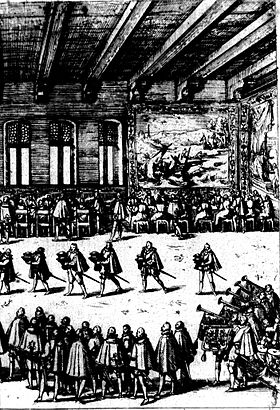Bridal table

The engraving bride panel of the engraver Frans Hogenberg was to celebrate the wedding of Crown Prince Johann Wilhelm with Jakobe of Baden-Baden in Dusseldorf created in 1585 and shows the bride panel. It was held by the court lawyer and Bergisch Landschreiber Diederich Graminaeus in the volume “Description of their princely Gülig wedding, so in the year of Christ one thousand five hundred eighty five, on the sixteenth of June and the following eight days, in Düsseldorf with great joy, princely triumph and glory been published in Cologne in 1587.
Descriptions
Georg Spickhoff
Spickhoff describes the copperplate in detail. The floor of the ballroom was strewn with flowers and its walls were decorated with tapestries. The theme of the tapestries was the Acts of the Apostles of Luke with the life and work of the Apostle Paul : including the story when in Lystra Paul and Barnabas were mistaken for gods ( Acts 15: 1-35 ), further the story as the Galilean king Agrippa Paul sent to Rome as a prisoner ( Acts 27.1-28.31 ). The wedding guests are also described on the board, along with the bride and groom, the representative of the emperor, and envoys from the Duke of Parma , the Netherlands, Bavaria, Cologne, Trier and Mainz. He goes on to describe the group in the middle who bring the dishes to the table. The group consists of a number of noble people, including the Lord von Hatzfeld-Wildenburg , ancestor of the Lords of Nesselrode . You will be guided by the master of ceremonies who will lead you to the table. The nobles were allowed to collect the dishes from the hall doors beforehand and carry them around the room. When they arrived at the table, they were allowed to present the food to the servants of the court at the table. In the foreground are the fanfare players and timpanists, musicians and singers, including important musicians from Liège and Cologne :
“ The great hall was built onto the palace for this purpose. Tapestries from the Acts of the Apostles were used to decorate the walls (left: the inhabitants of Listra, with the high priest at the head, want to make divine sacrifices to Paul and Barnabas, center left: the colonels of war tell King Agrippa about the deeds of Paul; center right: Shipwreck Pauli on the way to Rome; in the background the scene of Paul hurling back an adder that leaps from the fire to his hand and remains unharmed as a sign of his divine mission.) The floor is sprinkled with flowers. The ranking of the guests is from left to right: Under the canopy the bride, to her right the old duke, Sibylle, the ladies of the Baden relatives; to her left Johann Wilhelm, the Count of Manderscheid, as representative of the emperor; also the ambassadors of the Duke of Parma, governor Philip II in the Netherlands, the Bavarian court, the electors of Cologne, Trier, Mainz, the high nobility, etc. Council and cathedral chapters of the city of Munster were excused because of the war. All wedding guests are dressed according to the prevailing Spanish fashion, the women in white and gold brocade, the men in white taffeta with black silk mantillas, otherwise the colors of the duke prevail: incarnate-white-green. Attending the table was a high honor reserved for the nobility. The dishes were received at the hall doors by the nobles and brought to the table with the master of ceremonies preceded; There, the traditional dinners, cupbearers and pre-cutters took over the bowls and served them by hand. (Here, too, a large number of well-known names can be found, e.g. that of a Mr. von Hatzfeld-Wildenburg, ancestor of the current Rhineland Commissioner, a Mr. von Nesselrode, whose descendant was governor of Jülich-Berg at the time of Goethe's visit to Pempelfort.) His palace stands today still opposite the 'Schiffchen'. In the foreground on the right fanfare blowers and timpanists for the flourish of toasts and for the dance, (!) On the left musicians and singers for the table music, including by name e.g. Meister Heinrich, Domsangmeister zu Lüttich, Meister Wilhelm, Sangmeister zu St. Mergen in Cölln etc. The instrument on the table is a clavichord. The violins and the cello do not yet have their final Baroque form and are five-stringed. In the middle a part of the noble people watching. "
Diederich Graminaeus
In his work, Gramineus describes the bridal table:
- Descriptions of D. Graminaeus on the bridal table
Below the panel, Diederich Graminaeus wrote:
Since the day
tends to turn into night, the praying has already been accomplished,
lunch and conjugal duty
and delicious all the
dishes Braudt and Breudegam appear
The whole friendship in […]
going to table and evening […]
forgetting all sadness,
presented with great splendor
that delicious food into the night
and the end of the evening,
God's praise has not been forgotten.
photos
- Copper engraving (bridal table) by Frans Hogenberg
Individual evidence
- ↑ Georg Spickhoff: The brewery "zum Schiffchen" in Düsseldorf, commemorative publication for the three hundred year anniversary in April 1928 , Mathias Strucken Düsseldorf, 1928, pp. 22–24
Web links
literature
- Diederich Graminaeus: Description of their Princely Gülig wedding, held in the year of Christ one thousand five hundred eighty five, on the sixteenth of June and the following eight days, in Düsseldorf with great joy, Princely triumph and glory , Cologne 1587.




